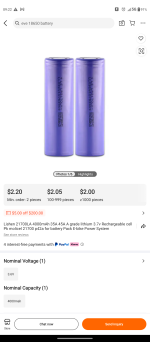My build so far is using an Amorge 72v40ah battery pushing 250A nominal and 350A peak,
The battery doesn't push current, it supplies whatever is demanded by the controller/motor, which is based on the load placed on them by the rider control input vs the terrain/riding conditions.
It has a limit to the current it can supply, which is usually those current (A) ratings you've listed. That limit just has to be greater than the maximum your system will ever need from it under any possible conditions, so that you don't damage it or stress it, and so that it won't shutdown when you need it most.
I don't know the brand personally, but if it's like many of the "cheap" brands, there are various potential problems with their choice of parts to build it with and possibly methods of assembly. I know there are posts on the forum that come up in a search on the name, but I only skimmed rapidly to see if there were big thumbs up or down comments on them, and didn't read any of them--you might want to before buying the battery (if you haven't already).
with (most likely) a 3kw motor/controller set off of alibaba where I'll upgrade the controller down the line. I might also just buy a motor and controller seperately, which is what I want to ask about. My questions are listed below:
Any specific reason for Alibaba? Copied from a recent post I made in another thread:
It's usually a place you go to buy hundreds or thousands of something, not just one, so not all sellers there will even talk to individuals (vs companies), even if they have listings for single items. Some of them also may require you transfer money to them via wire and perform the sale outside alibaba, which gives you no protection. There are also no enforceable warranties....
Depending on your location and requirements and budget, and any seller limitations you have, there are probably better places to get whatever you need, if you provide us with that information.
Here's some other questions (also from that thread) you might consider, as well. I've answered the other questions you posted below all that:
If you're set on alibaba, we'll still need to know the details of what system you actually want, what voltage and capacity of battery, etc., to help you find a kit.
Bicycle? Motorcycle? Moped? Scooter? (people's definition of "ebike" can include any or all of those, but "ebike", component-choice-wise, is really "electric bicycle" in the meaning of a bicycle-class EV, meant to be usable via pedalling and/or motor...the other things are really motor-only and not intended to be pedalled, whether or not they have any attached).
Based on the power levels of your part choices so far, you are probably building a motorcycle, not an ebike.

Speed required? Under what conditions?
Do you want a middrive, or a hubmotor?
Geared or DD Direct Drive hubmotor?
Do you want the bare hubmotor or one already laced in a wheel?
What size wheel? (diameter, width, axle type, dropout width, brake style, etc)
If middrive, what type? Bolt into custom-frame BB fixture? Slide into standard BB? BB width?
What features do you want the system to have? (there are many possible ways for it to work)
Do you need throttle operation? Grip? Thumb?
PAS? What type? Torque, cadence, on/off?
Assist levels?
Regen? On/off or variable?
Etc.
1. How do you figure out phase amps, what are they, and how do they affect the bikes total wattage, or power output in general
2. What's the difference between the amps coming out of the battery, and the phase amps
Phase amps are what the motor draws from the controller.
Battery amps are just the amps the controller draws from the battery.
PA can be higher than BA because the controller is a power converter, "same" watts in as out, but the form they're in is different, to provide the control to the motor necessary to do what the rider tells it to via whatever input controls you have.
3. Does the motor get any of those non-phase amps?
No, the motor is driven by the controller, not the battery, so it can't see battery amps.
4. What is wh defined as? I know it's the total energy stored in a battery (watt-hours) but what does it actually mean? Is it the amount of power a battery can put out in an hour, or how many continuous watts it can push out through an hour until it dies?
Wh is watt-hours. It's simply and only the capacity of the battery in relation to the nominal voltage (the average it has over the discharge curve). You could think of it as how many watts it could put out for one hour, so that half that power draw would last two hours, twice that power draw would last half an hour, etc, but it doesnt' tell you how many watts it can *actually* supply--that requires a completely separate rating.
The actual power it can supply (they don't push power or current) doesn't directly have anything to do with it's capacity rating.
You may have a 3kwh (3000wh) pack that is only capable of ever supplying 50 watts, depending on the cells used, their age, construction and interconnects, BMS if any, connectors, conditions it's being used under, etc. But it could supply that 50w for 60 hours.
Or you could have a 50wh pack that is capable of supplying 2500W, if it's got super duper cells, connections, etc in it. It would only last for about a minute before it was empty, though. (and it would probably get pretty hot; RC LiPo packs are occasinally used like this for tiny hobby cars/etc)
To be more confusing, there are terms like C-rate that use capacity in Ah to define the current output capability; that's usually only used with cells...so a 2C cell can safely supply 2x the amps that the cell is rated in Ah (A and Ah dont' directly have anything to do with each other, either, making it even more confusing, but you get used to it).
5. How would I pick out a controller based on the phase/line amps? I'm looking at a fardriver nd72360 because I've heard it's good, but all I see is the 360A phase and 170A line and I'm not sure if the 170 line is enough for my battery (question basically is: how do the battery amps get put into phase/line amps)
To really explain the BA to PA conversion, you'd need to read up on how controllers drive motors, and how they do their conversions internally; there are a number of threads here that go into that, but it isn't important unless you're wanting to design and build one.
The only thing that really matters is whether the controller can supply the current needed to make the torque the motor needs to do the job you need it to do.
The controller battery current limit is the limiting factor in your system, on purpose. It works backwards of the way you probably think it does, because the controller pulls amps from the battery, the battery doesn't push them, so you always want a battery with a higher A rating than the controller's battery A rating.
The process is:
You pick a motor that can handle the load you're going to put on it, that can spin as fast as you need it ot to drive the wheel at the speed you need, for the size wheel you're going to use and any reductions between motor and wheel (if it's not a hubmotor), that has the torque capability you need to accelerate at the speed you want to and climb the worst-case hllls against the worst-case winds on the worst-case terrain you have.
You then pick a controller that can supply the required current to drive that motor in the way you need it to, and can operate at a voltage that will spin the motor at the speed you need it to go, and has all the features you want it to have.
You then pick a battery of the right voltage to spin the motor at the speed you need to go, that doesn't charge too high for the controller's limits, and can supply more current (amps, A) than the controller will ever need, worst-case, and has enough capacity (Ah, Wh) to do that for the entire time you need it to do so to get the range you want.
Then you get into the details, after that.
6. What would you recommend as a motor/controller for this build? (budget is $1200 + hopefully $200 shipping, - about 800 for the battery with shipping so its like $400 + the extra $200 for shipping right now).
We cannot yet answer that question, as you haven't provided any info on what the bike must do for you under what riding conditions, worst-case.

I recommend checking out the motor simulator at ebikes.ca to see how the system parts interact with your riding conditions, using the pre-set parts they have there. Once you have an idea of how it works, after playing with it for a while, you can custom-set parts up to emulate the motor/controller/battery you want to try, and see how they may work for your needs.
You might find you need far less, or far more, of each of them than you presently expect.
7. On average, how much better does a controller get after doing a shunt mod, can it be done on a fardriver or sabvoton controller, and how many more watts/amps can a controller push than advertised (on average, or just for the one you recommend/the fardriver nd72360 if it's a good option).
It doesn't really get "better", just less reliable, though you might be able to push it well past it's normal limits. If you mean how far past those limits you can push it? Depends on what you do to it and how you use it--you'll know when you've pushed it to far when you're buying it's replacement.

A shunt mod makes it impossible for the controlelr to protect itself, the battery, or the motor, because it no longer has any idea how much current is actually flowing, so it's much easier to blow things up that way.
Depending on the controller design there may be ways to do a controlled mod by changing the elecronics between the shunt and the MCU (see various posts by Fechter / etc about that process), but that just means *you* know how much change there is--the controller can't know; thats the point of the mod to push it beyond it's built in safety limitations.
Most controllers are made as cheaply as possible, so they barely have good enough parts and construction to do the job they say they can do...the cheaper they are (cost and construction) the more likely it is a shunt mod will push them past their abilities and blow something up--and that is most likely to happen at the moment you most need the extra power, and leave you with a fried system and a long walk home, or if it fails in traffic while you're trying to avoid something bigger than you are, it could be fatal.
Plenty of success stories, but plenty of "oops" ones too.

I've had both. Some people just keep replacing the cheap ones they blow up doing this, some do it once and it keeps working.
I would recommend picking a controller (and motor, and battery) that is actually capable of what you need it to do, unless this whole thing is just for fun and nothing on it or about it is "mission critical" for you, and you have plenty of money to replace things that blow up.

Almost always cheaper to buy right once than to re-buy insufficient multiple times.






